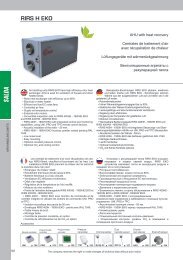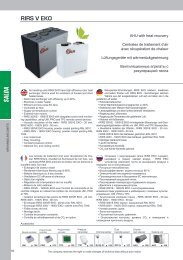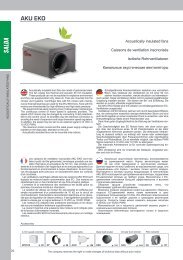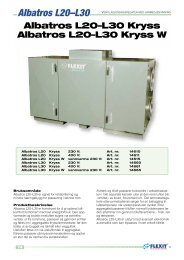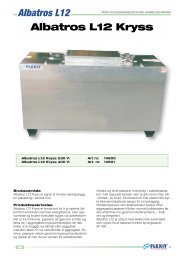domestic and industrial fans Wohnraumlüfter und ... - VTPrincips
domestic and industrial fans Wohnraumlüfter und ... - VTPrincips
domestic and industrial fans Wohnraumlüfter und ... - VTPrincips
You also want an ePaper? Increase the reach of your titles
YUMPU automatically turns print PDFs into web optimized ePapers that Google loves.
Calculating the pressure<br />
losses in long ducting<br />
When the air is extracted through long<br />
ducting its flow can be hampered by duct<br />
elbows or bends; install a centrifugal exhaust<br />
fan increasing the air flow inspite of these<br />
obstacles. After determining the right air flow<br />
of the suitable centrifugal fan add the data<br />
regarding pressure losses as follows:<br />
• Example B:<br />
Determine the air flow <strong>and</strong> pressure losses of<br />
a 2,5 (l) x 2 (w) x 3 m bathroom with straight<br />
air extraction ducting.<br />
The dimensions of the duct are Ø100 mm<br />
<strong>and</strong> 8 m length.<br />
Install a centrifugal fan <strong>and</strong> calculate as<br />
follows:<br />
the volume of the room (2,5x2x3 = 15 m3 ),<br />
consult the air changes table per hour where<br />
you can find the needed air flow: 10.<br />
10 x15 = 150.<br />
The air flow is 150 m3 /h. Add to these data<br />
the duct structure losses fo<strong>und</strong> in the table.<br />
How to consult the pressure losses table<br />
a) Find the diagonal corresponding to the<br />
diameter of the duct. In this case (ex. B) it<br />
100 mm, (green line)<br />
b) cross this diagonal with the horizontal line<br />
corresponding to the established flow (150<br />
m3 /h), fo<strong>und</strong> on the left side of the table,<br />
(yellow line)<br />
c) draw a vertical line (blue line) from the<br />
cross point, read the resistance in H20 per<br />
duct meter. (In this case our duct is 8 m long:<br />
it results 0,40 mm H2O).<br />
d) the total pressure loss is<br />
8 x 0,40 = 3,2 mm H2O<br />
The suitable centrifugal exhaust fan is<br />
OC 200 SUPER having 7,5 mm H2O pressure<br />
at 150 m3 /h air flow<br />
Example B - Calculating pressure losses<br />
Beispiel B - Berechnung der Rohreibungs<br />
Verluste<br />
Example B - Calcul des pertes de charge<br />
AIR FLOW (m 3 /h)<br />
LUFTFORDERMENGE (m 3 /h)<br />
DEBIT (m 3 /h)<br />
150<br />
500<br />
400<br />
300<br />
200<br />
100<br />
80<br />
70<br />
60<br />
50<br />
40<br />
30<br />
20<br />
15<br />
10<br />
300<br />
280<br />
260<br />
240<br />
220<br />
200<br />
180<br />
160<br />
140<br />
120<br />
100<br />
90<br />
1<br />
0,8<br />
SPEED •GESCHWINDIGKEIT • VITESSE m/sec<br />
3<br />
2,8<br />
2,6<br />
2,4<br />
2,2<br />
2<br />
1,8<br />
1,6<br />
1,4<br />
1,2<br />
Berechnung der<br />
Rohrreibungsverluste.<br />
Die Entlüftung über lange Rohrleitungen<br />
erzeugt Druckverluste wegen der<br />
Rohrreibung <strong>und</strong> eventueller Kanalbögen.<br />
Zur Förderung dieser Widerstände raten wir<br />
Ihnen einen Radialventilator zu installieren.<br />
Nachdem man das Gerät mit der richtigen<br />
Luftförderleistung bestimmt hat, muß man<br />
den eventuellen Druckverlust, der sich durch<br />
den Rohrleitungswiderst<strong>and</strong> ergibt ,<br />
beachten.<br />
• Beispiel B:<br />
Gesucht werden Luftfördermenge <strong>und</strong><br />
Druckverluste eines Badezimmers (2,5x2x3 m)<br />
mit einer Entlüftung über eine gerade<br />
Kanalleitung (Länge = 8 m; Durchmesser =<br />
100 mm). In diesem Fall wird ein<br />
Radialventilator installiert <strong>und</strong> folgendes<br />
beachtet:<br />
Rauminhalt: 2,5 x 2 x 3 = 15 m 3<br />
Angegebener Wert in der Tabelle<br />
(Luftwechsel pro St<strong>und</strong>e in einem Bad = 10)<br />
10 x 15 = 150 m 3.<br />
Die Luftfördermenge ist 150 m 3 pro St<strong>und</strong>e<br />
Wie Sie den Druckverlust errechnen wird<br />
Ihnen wie folgt erklärt.<br />
a) bestimmen Sie die Diagonale , die dem<br />
Rohrdurchmesser entspricht, in unserem<br />
Beispiel 100 mm (grüne Linien).<br />
b) Stellen Sie auf der linken Seite der Tabelle<br />
fest, welche Luftfördermenge Sie benötigen<br />
(gelbe Linie) (150 m 3 pro St<strong>und</strong>e) <strong>und</strong> ziehen<br />
Sie eine waagerechte Linie, bis Sie die<br />
vorher ausfindig gemachte Diagonale<br />
kreuzen.<br />
c) Wenn Sie nun eine senkrechte Linie (blaue<br />
Linie) von dem Schnittpunkt nach unten<br />
ziehen, können Sie den Widerst<strong>and</strong> (in mm<br />
H2O) pro Meter des Rohres ablesen. In<br />
unserem Fall: 0,40 mm H2O.<br />
d) da das Rohr in unserem Beispiel 8 m lang<br />
ist, rechnen Sie: 8 x 0,40 = 3,2 mm H2O.<br />
Der geeignete Ventilator ist OC 200 SUPER,<br />
er hat bei einer Luftfördermenge von 150 m 3<br />
pro St<strong>und</strong>e einen Druck von 7,5 mm H2O.<br />
Ducting diameter (mm)<br />
Rohrdurchmesser (mm)<br />
Diamètre du conduit (mm)<br />
6<br />
5,5<br />
5,2<br />
4,5<br />
4<br />
3,5<br />
0,01 0,02 0,03 0,05 0,07 0,1 0,2 0,3 0,4 0,5 0,7 1 2 3<br />
PRESSURE LOSSES (mm H2O x 1m duct)<br />
DRUCKVERLUSTTABELLE (mm H2O x 1m Rohr)<br />
PERTES DE CHARGE (en mm H2O x 1m de conduit)<br />
Air treatment<br />
Luftbeh<strong>and</strong>lung<br />
Traitement de l'air<br />
Calcul des pertes de charge<br />
Si le refoulement se passe à travers des<br />
conduits longs ayants des coudes ou des<br />
étranglements il vaut mieux d'installer un<br />
aérateur centrifuge qui peût vaincre les<br />
obstacles qui se trouvent à l'intérieur de la<br />
canalisation.<br />
Après avoir déterminé le débit d'air de<br />
l'appareil considérez les pertes de charge<br />
provoquées par la résistance du conduit:<br />
• Exemple B:<br />
Pour calculer le débit d'air d'une salle de<br />
bain qui mèsure 2,5 x 2 x 3 dont le<br />
refoulement se passe dans un conduit<br />
canalisé droit (8 m de longueur e Ø 100<br />
mm), on installe un aérateur centrifuge et<br />
on calcule le volume de la pièce<br />
(2,5 x 2 x 3 = 15m3 ) en consultant la table<br />
des changements par heures<br />
vous trouvez 10. 10 x15=150.<br />
Le débit d'air est 150 m3 /h.<br />
Comment utiliser la table des pertes de<br />
charge:<br />
a) déterminer la diagonale qui correspond<br />
au diamètre du conduit, en ce cas<br />
exemple B, 100 mm. (ligne verte)<br />
b) Croiser cette diagonale à la ligne<br />
horizontale qui se réfère au débit établit<br />
dans la partie gauche de la table<br />
(150 m3 /h) (ligne jaune)<br />
c) Tracez une ligne verticale (ligne bleue) à<br />
partir du point où les valeurs mentionnées<br />
(exemple B) se croisent: elle détermine la<br />
résistance en mmH2O par mètre de conduit,<br />
en ce cas 0,40 mmH2O.<br />
d) Puisque notre gaine a une longueur de<br />
8 m la perte totale du conduit est:<br />
8 x 0, 40 = 3,2 mm H2O.<br />
L'aérateur indiqué est OC 200 SUPER:<br />
il a une pression de 7,5 mmH2O à un débit<br />
de 150 m3 /h<br />
P (mm H2O)<br />
35<br />
30<br />
25<br />
20<br />
15<br />
10<br />
7,5<br />
5<br />
0<br />
OC 200 SUPER<br />
20 40 60 80 100 120 140 160 180 200<br />
150<br />
Q (m 3 /h)<br />
7





